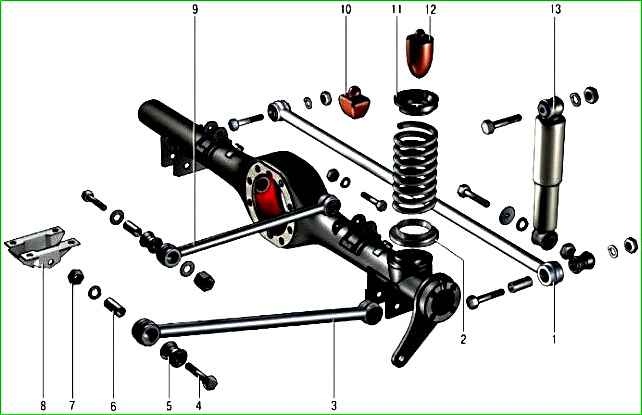The rear suspension of the car is dependent, includes a guide device, elastic elements and devices that dampen body vibrations
The rear axle beam is connected to the body by means of reaction rods - two lower 3 and two upper 9 longitudinal and one transverse rod 1.
The longitudinal rods transmit pushing and braking forces from the drive wheels through the rear axle beam to the body. The crossbar prevents the body from lateral displacement.
The reaction rods are attached to the body brackets and the rear axle beam via rubber-metal hinges, which are structurally identical and differ only in size.
The hinge consists of a rubber bushing 5 installed in the rod eye, a spacer sleeve 6 that passes through the hole in the rubber bushing, a thrust washer and a rod mounting bolt.
The elastic elements of the suspension consist of coiled cylindrical springs, two main buffers 12 for compression travel and an additional compression buffer 10.
The spring installed in the suspension rests with its upper end on the support cup through a rubber insulating gasket 11, which is placed in a stamped steel cup of the body.
The lower end of the spring rests on the rear axle beam cup bridge through the insulating gasket 2.
The main buffers 12 are installed inside the springs and secured with a mushroom-shaped retainer in the holes of the upper supports.
The additional buffer 10 is mounted on a bracket bolted to the bottom of the body.
The damping device consists of two hydraulic shock absorbers.

Check the condition of the rear suspension from underneath the car installed on a lift or inspection pit. The following are not allowed on rubber suspension parts:
- – signs of rubber aging;
- – mechanical damage.
Signs of aging, cracks, one-sided bulging of the rubber mass are not allowed on rubber-metal hinges.
Replace defective parts.
Check for mechanical damage (deformations, cracks, etc.) to suspension elements, especially suspension rods and the crossbar bracket on the body.
Possible rear suspension malfunctions and troubleshooting methods
- Cause of malfunction
Remedy
Noise and knocking in the suspension when the car is moving
- Shock absorbers are faulty
Replace or repair shock absorbers
- Loose shock absorber mounts or worn shock absorber lug bushings
Tighten shock absorber mounting bolts and nuts, replace worn or damaged parts
- Spring settling or breakage
Replace the springs as a set
- Knocking from suspension "breakdown" due to damage to the compression buffer or overload of the rear suspension
Replace damaged buffers, unload the rear suspension of the car
Frequent "breakdowns" of the rear suspension
- The rear axle of the car is overloaded
Unload the rear axle
- Spring settling or breakage
Replace the springs as a set
- They do not work shock absorbers
Replace or repair shock absorbers
Car drifts away from straight-line movement
- Different air pressure in tires
Set normal tire pressure
- Subsidence or breakage of one of the suspension springs
Replace the springs as a set
- Rear axle offset due to deformation of the rear suspension rods
Straighten or replace the rods





